
|
Sale 80
June Pre Long Beach Sale
| Lot |
Photo |
Description |
Realized |
Lot 1804 |
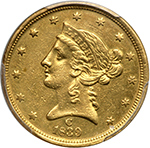 |
1839-C. PCGS graded Genuine, Filed Rims - AU Details. Light gold obverse toning while the reverse shows lovely red and golden toning. Only 17,205 struck. The details on the obverse relief features are boldly struck save for some flat stars, and more than you see with most of the surviving 1839-C half eagles. The reverse stands slightly below this inasmuch as the right side of the eagle from shield down to claw failed to completely strike. All this same, the leaves the viewer wide-mouthed and in awe at the remarkable sharpness found on Liberty's hair and hair bun for such an early Charlotte branch mint gold coin.
Among the earlier dates none are more popular than those struck at the Dahlonega and Charlotte mints, in this era the metal used was being supplied from the regional hills and valleys (interestingly, during the 1850s much gold from California was shipped to these two mints, changing the scenario). In the first year, 1839, the mintmarks were placed on the obverse. The idea lasted but a short time, and beginning in 1840 the reverse was used, the same being true in the silver half dollar series (PCGS # 8192) .
Estimated Value $1,500 - 1,600.
View details and enlarged photos
Check results on similar lots
| Realized
$2,938 |
Lot 1805 |
 |
1841-C. PCGS graded MS-61. Frosty. Only 21,467 struck. Well struck at main devices with some unusual roughness and lack of detail around the wide borders which have partial wire rims. Plenty of satiny mint luster, however, remains and all is lightly golden colored. Indeed, the strike on this early C-mint rarity is all that could be desired: full hair waves (including the long curl above the ear which is exquisitely detailed, clear hair bun and beaded cord. And equally impressive eagle where the neck and leg feathers show complete definition, as does the shield. The leaves show their central veins; the arrowheads, their shafts. Bold square rims act like a picture frame around the entire composition. A substantial number of light handling abrasions on the reverse. Gold coins, when stored in bank vaults to back paper money circulation, were often stored in bags or chests and moved around a great deal. See anecdote which follows. A worthwhile bid is called for to obtain this handsome specimen. Pop 4; 3 finer, 1 in 62, 2 in 62+ (PCGS # 8203) .
Humorous Anecdote: Andrew Dickson White, the founder of Cornell University, writes in his 19th century autobiography that when he was a young man he would sometimes accompany a bank examiner on his regular auditing rounds into the rural districts of Michigan. They had a regular game they played between the circuit rider on horseback (the bank auditor) and the often times shady bankers who were in cahoots with each other. It was well known that when word got out in a district that the examiner had just done the books and checked the gold reserves of a bank, a messenger on fast horseback would be sent forth with the same bag of gold coins that had just been audited, and race ahead of the examiner to the next bank up the line. (That bank would often be owned by the same individual.) When the bank examiner finally arrived a day or two later at the second bank to do its accounts, he�d find everything proper, the books balanced and the gold reserve adequate. The examiners knew they were being hoodwinked, that they were viewing the same gold coins over and over again. They were no fools. Everyone played at the charade. And that was how the game operated in the days of Wildcat Banking in the 1840s and 1850s! (Perhaps this heavy handling and constant movement explains some of the surface marks and abrasions on otherwise obviously Mint State gold coins of the 19th century.).
Estimated Value $14,000 - 15,000.
View details and enlarged photos
Check results on similar lots
| Realized
$17,625 |
Lot 1806 |
 |
1842-C. Large Date. PCGS graded AU-58. A nice untoned coin. Only 23,589 minted. A nicely struck example of this elusive C mint release in which the lower obverse rim dentils are somewhat weak and along with them, the upper reverse dentils as though the dies were either slightly misaligned or the inner design "pulled" the metal away from the rim, denying the dies sufficient metal to fill the denticle recesses along those areas. All in all this is a handsome, lustrous and attractive coin. There are very few surface abrasions. There is much mint frostiness. And it has eye-appeal far and away nicer than average for and 1840�s decade Charlotte Mint half eagle. With its great all-around eye appeal, this is an absolutely must-have coin that deserves a place in the better class of rare gold cabinets. Pop 4; 9 finer, 2 in 61, 3 in 62, 4 in 63 (PCGS # 8209) .
Estimated Value $6,500 - 7,000.
View details and enlarged photos
Check results on similar lots
| Realized
$7,344 |
Lot 1807 |
 |
1842-C. Large date. PCGS graded Genuine, Cleaning - AU Details. A hint of gold tone. Only 23,589 struck. Walter Breen attributes a mintage of 23,589 to the Large Date variety, or over four times that of the Small Date. On the other hand, Douglas Winter estimates that 35 to 40 are known of the Small Date and 65 to 70 of the Large Date, obviously a different proportion. During this era date sizes were in flux at the Philadelphia Mint, and across certain denominations; the years 1842-1846 are found with different-sized logotypes, not for all denominations and all years, but for enough of them that they make an interesting study (PCGS # 8209) .
Estimated Value $1,000 - 1,100.
View details and enlarged photos
Check results on similar lots
| Realized
$1,645 |
Lot 1808 |
 |
1842-D. Small date. NGC graded AU-53. Some mint luster present. Normal field abrasions from the time it spent in circulation. Well detailed, nevertheless, for this often difficult D-mint half eagle, a low mintage year. With light golden highlights that add considerably to the appeal of this higher-end circulated specimen. Devices are about as sharp as can be expected, with only some minor weakening in the outline of the shield on the reverse, the eagle�s neck detail, and some feathers along the legs. Legends, date, and mintmark are all clear. In 1842, the Dahlonega mint tested various with date and lettering sizes. This was an era when experimentation took place at every mint, that lasted from about 1838 to 1843. The 1842-D Small Date is seen more often than its Large Date equivalent (the opposite is found on the Charlotte half eagles dated 1842 where the 1842-C Small Date is rarer) (PCGS # 8210) .
Estimated Value $2,500 - 2,700.
View details and enlarged photos
Check results on similar lots
| Realized
$2,350 |
Lot 1809 |
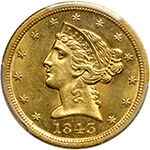 |
1843-C. PCGS graded MS-62. CAC Approved. Nice light golden toning. Only 44,277 minted. Glowing yellow to orange-gold surfaces show strong luster and a minimum of marks of any consequence. Nicely struck in most areas. Liberty is nicely frosted against the somewhat reflective background. Rarer than its mintage indicates, and typically found Very Fine or Extremely Fine, usually well abraded. From the population reports, we know that a handful of 1843-C Fives exist in MS62 and finer grades. Rather than believe that all of a sudden a flurry of Mint State 1843-C $5 pieces have mysteriously appeared on the market in recent times, we suggest that certification numbers might be padded by resubmissions of identical coins. In absolute terms, this MS62 1843-C half eagle is a highly prized rarity.
Evidently, one obverse die was shipped to Charlotte on December 23, 1842. This was used in combination with two reverses on hand from earlier times. It would seem reasonable that additional obverses might have been sent later, as it was not policy at the time to take a chance that the only die on hand might break, thus halting coinage of the most popular denomination. Walter Breen, the source for much early Half Eagle die information, mentions only the shipment of a single die. Pop 4; 5 finer, 2 in 63, 3 in 64 (PCGS # 8214) .
Estimated Value $12,000 - 13,000.
View details and enlarged photos
Check results on similar lots
| Realized
$16,744 |
Lot 1810 |
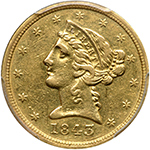 |
1843-D. Medium D. PCGS graded Genuine, Cleaning - XF Details. Some light marks in the fields. Only 98,452 struck. When encountered, the 1843-D is usually seen in VF condition, occasionally EF, and not often AU. Perhaps a couple thousand 1843-D half eagles exist today, this possibly being a generous estimate (PCGS # 8215) .
Estimated Value $800 - 850.
View details and enlarged photos
Check results on similar lots
| Realized
$1,234 |
Lot 1811 |
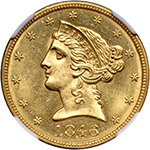 |
1846. Large Date. NGC graded MS-64. Boldly struck with semi-reflective fields. A thin bisecting die crack runs from the rim across the wing to the opposite rim as it passes across the D in the denomination. Highly lustrous bright golden color with moderate prooflike reflectivity on both sides. Considerably more rare in Mint State than its generous mintage of 395,942 pieces would lead one to suppose. Most known specimens are Very Fine to Extremely Fine, and did their duty in circulation, to which can be added a relative scattering of About Uncirculated pieces. The present coin, graded MS64, stands near the upper end in quality among pieces of which we are aware. This is one of the finest pieces we have auctioned in and for many collectors, may represent a once-in-a-lifetime opportunity to bid. Pop 4; 2 finer in 64 Star (PCGS # 8226) .
Estimated Value $13,000 - 14,000.
View details and enlarged photos
Check results on similar lots
| Realized
$9,106 |
Lot 1812 |
 |
1846. Small Date. NGC graded MS-62. Light hint of gold tone. Some luster still evident having prooflike aspects to it. Bright yellow gold with some orange toning highlights. Sharp and lustrous, and very attractive for the grade. Scarcer than the Large Date variety of the year. On the obverse, a small die chip is noted at the lower right foot of the 4 in the date. Pop 2; 2 finer in 63 (PCGS # 88226) .
Estimated Value $4,000 - 4,500.
View details and enlarged photos
Check results on similar lots
| Realized
$5,640 |
Lot 1813 |
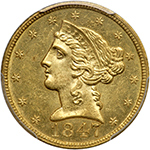 |
1847-C. PCGS graded MS-63. Well struck and lustrous. The surfaces are radiant and each side has a nice veneer of vivid and frosty golden patina that whips and tosses about as it alternates between heavier frost (on the portrait and eagle) and slightly smoother luster shades in the surrounding field. All this is perhaps obvious from the photos. What we need to put emphasis on also is that the strike is unusually crisp and detailed for this important C-mint issue. It displays sharp metal flows into the deepest recesses of the dies on both sides. Complete stars and bold date; resolute hair waves and coronet with a strong LIBERTY inscribed thereon. The trend continues on the other side, for the reverse is quintessential sharp strike, including all eagle feathers, the shield and legends, as well as the rim dentils. A bold example of this desirable Charlotte, North Carolina branch mint Half Eagle.
Half eagles were coined at Charlotte nearly every year from 1838 to 1861 with the exception being 1845, when the mint was under repair from a catastrophic fire that had nearly destroyed it the year before. The greater utility of this denomination and its more widespread popularity with depositors resulted in higher mintage for this denomination than for quarter eagles. The record was set in 1847, when 84,151 five-dollar pieces were struck. Mintages rarely went below 10,000 pieces, though 6,879 half eagles were struck in 1861, the final year of operation. Pop 2; 1 finer in 65 (PCGS # 8233) .
Estimated Value $22,000 - 24,000.
View details and enlarged photos
Check results on similar lots
| Realized
$32,900 |
Lot 1814 |
 |
1847-C. PCGS graded MS-61. Nice light golden toning. Only 84,151 minted. A remarkable frosty coin that emits eye-catching gold color, few no marks and no problems to speak of or for the skeptic to find. A dullish impression was often left by the recoil of the dies that struck most Charlotte Mint Half Eagles, almost accepted as a rule when it comes to this Mint; however, some were much more carefully made and we are pleased to see and report that this is a splendid exception to that rule. Stars are full on the obverse, as is Liberty�s hair and hair bun. There is only minor blurriness in LIBERTY at the coronet. The reverse continues the sharp detail, which is seen in full neck and leg feathers, a sharp wing, perhaps a slightly rounded shield in spots but nothing even approaching the usual "weak" areas. Frosty. Very choice surfaces. Top-notch eye appeal. Pop 4; 5 finer, 2 in 62, 2 in 63, 1 in 65 (PCGS # 8233) .
Estimated Value $10,000 - 11,000.
View details and enlarged photos
Check results on similar lots
| Unsold |
Lot 1815 |
 |
1851. PCGS graded EF-45. Nice golden toning (PCGS # 8246) .
Estimated Value $400 - 425.
View details and enlarged photos
Check results on similar lots
| Realized
$494 |
Lot 1816 |
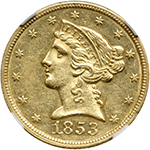 |
1853-C. NGC graded MS-60. Only 65,571 minted. Mostly untoned. Pop 6; 19 finer, 1 in 60+, 4 in 61, 9 in 62, 2 in 63, 3 in 64 (PCGS # 8254) .
Estimated Value $5,000 - 5,500.
View details and enlarged photos
Check results on similar lots
| Unsold |
Lot 1817 |
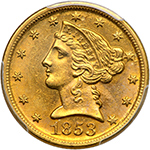 |
1853-D. Large D. PCGS graded MS-63. Well struck with lovely golden toning. Brilliant, satiny with warm golden to light orange-gold luster and only a scattered few microscopic hairlines or abrasions. Full central strike which is a pleasant reminder that some D-mint issues were indeed very well made. This MS63 specimen being a "keeper" for anyone who recognizes how beautiful it is. Also, far above average in aesthetic quality. Of importance to the specialist are the peripheral details, including complete details of every star, except stars 10 and 13 which are slightly weak. This is clearly the single most available Dahlonega Mint half eagle regular circulated grades to low-end Mint State 60 and 61. The present Choice specimen has a rare combination of high standards and truly outstanding visual appeal -- to see it is to love it! We expect that even the most seasoned Dahlonega Mint aficionado will want to bid freely to acquire this remarkable coin. Pop 5; 1 finer in 64 (PCGS # 8255) .
Estimated Value $12,000 - 13,000.
View details and enlarged photos
Check results on similar lots
| Realized
$7,931 |
Lot 1818 |
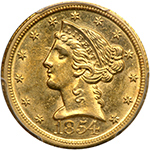 |
1854-D. Large D. PCGS graded MS-62. Mostly untoned. Only 56,413 minted. A satiny coin with energetic luster beaming across the surface on both sides, this includes light golden color that seems to want to motivate bidders to increase their bids as though by subtle hypnosis! Clear-cut devices point to the coin having been giving a full strike by the dies. Rims free of bruising and all dentils show nicely. We�d like to repeat and emphasize that the mint luster rolls around both sides with a pleasing sheen. A thoroughly delightful coin, a thoroughly marvelous opportunity! Pop 8; 6 finer, 3 in 63, 1 in 64, 1 in 64+, 1 in 65 (PCGS # 8258) .
Anyone with a general interest in American gold coins will enjoy the opportunity to make a serious beginning in the popular Charlotte Mint and Dahlonega Mint series, as well as acquire examples of just about any other desired date and mintmark within the Half Eagle denomination. In the coming years numismatists will be very proud of the pieces that bear Dahlonega�s famous and historic "D" mintmark. The color of the Dahlonega gold coins was more a function of the minting methodology employed at the facility, than of the raw material from which they were produced. In fact, the Dahlonega Mint produced gold coins from a variety of gold sources: naturally-occurring gold (from Georgia, as well as other states), foreign gold coins, gold bullion, scrap gold, etc. The Dahlonega Mint even produced coins from gold that was brought in from great distances. For example, the Dahlonega Mint actually coined a great deal of California gold from 1851-1854, which was brought back by local miners returning from the California gold fields. Thus, there is no foolproof way to know whether or not a particular Dahlonega gold coin was produced from locally mined metal.
The evidence shows that the gold coins produced at Dahlonega had a "high" silver concentration (when compared with gold coins produced at the parent mint in Philadelphia). Although some other regions (such as California) generally had lower purity gold, the lower purity gold had to be refined prior to minting, thus removing most (or perhaps virtually all) of the silver. The resulting gold would then be alloyed with copper and perhaps a small amount of silver. Thus, the resulting gold coins had less silver than their Dahlonega cousins. Also, the "green gold" characterization of some Dahlonega gold is a visual interpretation of color differences among coins and is therefore very subjective.
Estimated Value $11,000 - 12,000.
View details and enlarged photos
Check results on similar lots
| Realized
$12,338 |
Lot 1819 |
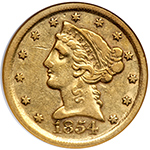 |
1854-D. Large D. NGC graded EF-45. A bold strike. We note a scratch in the left obverse field in front of Liberty's eye. The central motifs are well displayed, with most of Liberty's detail and the eagle and shield showing plainly. No obverse rim denticles, possibly due to a worn did since this portion of a coin die experiences major stress and wear during coining. Only 56,413 minted (PCGS # 8258) .
Estimated Value $1,500 - 1,600.
View details and enlarged photos
Check results on similar lots
| Realized
$1,880 |
Lot 1820 |
 |
1855-C. PCGS graded AU-58. Nice golden toning. Only 39,788 minted. A small mark by star 2 can be used to identify this coin. There is much to say about the beautiful color and originality of this frosty coin since they are clearly higher quality than the usual Very Fine to Extremely Fine specimen from this branch mint. A quality most difficult to obtain. The mint frost is aglow around and throughout the main devices on either side. There is just a bit of light yellow-gold patina as well. This is an otherwise strongly struck example, including nice detail to all the important high points, with the possible exception of these regions (standard for the issue): the eagle�s claws, some neck feathers, and minor rounding on the arrowheads and shield outline. Large C mintmark occupies the center area between the denomination and the branch end. Pop 5; 3 finer, 1 in 60, 1 in 62, 1 in 63 (PCGS # 8262) .
Estimated Value $5,000 - 5,500.
View details and enlarged photos
Check results on similar lots
| Realized
$7,638 |
Lot 1821 |
 |
1856. PCGS graded MS-63. Lovely light golden toning. Lustrous golden color with warm toning, definitely a coin that has grand overall eye appeal. The above-average strike complements this eye-appeal, some might say, adds immeasurably to its appearance. Pop 4; 3 finer, 2 in 64, 1 in 65 (PCGS # 8266) .
Estimated Value $7,000 - 7,500.
View details and enlarged photos
Check results on similar lots
| Unsold |
Lot 1822 |
 |
1856-D. PCGS graded MS-61. A few obverse marks. A nice untoned example. Only 19,786 minted. Elusive and quite costly in higher grade, this just-miss Select Mint State example is free of noticeable rim bruises and the strike is outstanding, well above par for the Dahlonega Mint and both sides reveal original mint frost. Pop 9; 19 finer, 12 in 62, 3 in 63, 4 in 64 (PCGS # 8268) .
Estimated Value $9,000 - 10,000.
View details and enlarged photos
Check results on similar lots
| Unsold |
Lot 1823 |
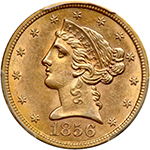 |
1856-S. PCGS graded MS-61. Lovely rich golden toning. A satiny lustrous example of this early S-mint release (third year that the San Francisco Mint was open for business), and a Half Eagle with a wealth of underlying luster on its warmly toned surfaces. Nicely struck in all areas with no sign of weakness anywhere on the design. A lovely and elusive coin, pieces such as this are among the most sought-after items in all of numismatics. Pop 1; 2 finer, 1 in 62, 1 in 64 (PCGS # 8270) .
Estimated Value $9,000 - 10,000.
View details and enlarged photos
Check results on similar lots
| Realized
$12,338 |
Lot 1824 |
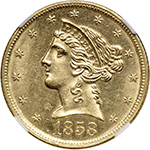 |
1858-C. NGC graded MS-64. Well struck and untoned with semi-reflective fields. Only 38,856 minted. Needle sharp! A hint of weakness at that is typically seen on 1858-C half eagles (those of lesser quality, we must remind readers) is entirely missing on this remarkable specimen, with the key central regions strongly impacted by the coining dies. Sometimes it seems these Southern Mints just dashed-off the stuff without attention to quality control. In other words, either lack of initiative (or more logically, lack of aptitude) by the mint staffers tended to produce less that full strikes. That isn't the case with this marvelous 1858-C. A beautiful golden-bright MS64 coin with no objectionable marks or blemishes other than for some slight roughness in the surface or planchet on the reverse field as struck. Words are inadequate to describe the reward the successful bidder will receive when he lands this romantic Charlotte Mint Half Eagle, for it stops just shy of Gem quality, and is, by the NGC census indicated here: Pop 1; none finer at NGC (PCGS # 8277) .
Estimated Value $35,000 - 38,000.
View details and enlarged photos
Check results on similar lots
| Realized
$43,475 |
Lot 1825 |
 |
1858-D. NGC graded MS-60. Nice light golden toning. Frosty surfaces display a fair amount of mint brilliance and strong natural golden shading. Sharply struck in all areas barring two stars, an extraordinary departure from the weakness of strike this date typically presents. From the scant mintage of 15,362 pieces, few specimens can be found today in any grade above Extremely Fine. The present Mint State 60, with a solid grade number plus the important aspect of sharp strike and aesthetic appeal should combine to create a buyer�s picnic where, to the consignor�s pleasure, a whole cadre of bidders may show up to bid. Pop 2; 8 finer (PCGS # 8278) .
Estimated Value $7,500 - 8,000.
View details and enlarged photos
Check results on similar lots
| Realized
$4,465 |
Lot 1826 |
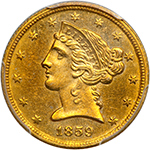 |
1859-C. PCGS graded MS-62. Only 31,847 minted. Lovely golden toning. The warm golden hue is rich with color, orange to peach tinged and more evident on the obverse where it nearly encompasses the entire surface. On the reverse, the color hugs the edge, yielding but grudgingly to the more typical reddish tint of standard 90% gold 10% copper "coin gold." Adding to those results, a word about strike: this piece has all but needle-sharp devices on the obverse, with gorgeous detail on the stars, the date digits, Liberty�s hair but especially the coronet. Fully struck in most obverse areas as this is, some unconvincing roundness here and there is "standard issue" for the reverse, including a softly impressed eagle and shield. However, these minor drawbacks are compensated by outstanding surface quality. The surface is free of most marks in a gold Type which tended to be heavily abraded, even on the few surviving Mint States. (The identical reverse die was used in Charlotte in the following year, 1860, with the same comments regarding the reverse die being appropriate for half eagles of that date as well.) Pop 1; 3 finer, 2 in 63, 1 in 66 (PCGS # 8281) .
Estimated Value $11,000 - 12,000.
View details and enlarged photos
Check results on similar lots
| Realized
$7,344 |
Lot 1827 |
 |
1860-C. PCGS graded Genuine, Repaired - XF Details. Mostly untoned. Only 14,813 struck. The reverse on the 1860-C half eagles shows some lightness of strike on the neck and among the lower details of the eagle�s claws and arrow feathers, this being typical for the issue. This weakness appears to be more a result of poor detail in the original coinage die, than weakness of strike. Doug Winter attributed this to die rust: "There is very extensive rust on the neck of the eagle, its wings and claws, and over the shield and olive leaves. This rust makes these details appear blurred. The borders, on the other hand, are considerably sharper with strong lettering, denticles and a bold mintmark." (PCGS # 8285) .
Estimated Value $800 - 850.
View details and enlarged photos
Check results on similar lots
| Realized
$1,175 |
Lot 1828 |
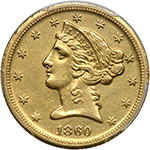 |
1860-D. Medium D PCGS graded Genuine AU Details. Cleaning. Mostly untoned and well struck. With the clouds of war building, the Dahlonega Mint reduced production in 1860 and 1861. This is a fairly scarce Half Eagle from the end of this Mint's existence. Only 14,635 minted (PCGS # 8286) .
Estimated Value $750 - 800.
View details and enlarged photos
Check results on similar lots
| Realized
$2,115 |
Lot 1829 |
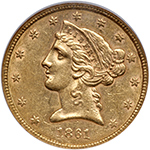 |
1861. NGC graded AU-58. Popular Civil War issue, some luster can be found within the devices and around the stars, date digits and throughouot the reverse legend. Production rose in 1861 when merchants, gold holders and miners, rushed to the mint to convert their bullion or foreign coins and scrap gold into coined money, fearing the effects from wartime conditions (PCGS # 8288) .
Estimated Value $550 - 600.
View details and enlarged photos
Check results on similar lots
| Realized
$705 |
Lot 1830 |
 |
1861-C. PCGS graded Genuine, Cleaning - AU Details. Lightly toned. Only 6,879 struck. Related to the numismatic background of this rare issue, the salvo on Fort Sumter in the harbor of Charleston, SC, on April 12-13, 1861, initiated the Civil War, although secession started in December 1860, with South Carolina having broken away from the Union. After Fort Sumter, which was a Customs House, was abandoned, it was all-out armed conflict. Panic ensued in the North since the Union depended on the Customs Houses for its funding. Import Tariffs collected there were a major component of the government's annual income. The southern state and Confederate command seized whatever federal buildings and machinery they could. On April 20,1861, a Confederate flag was hoisted over the Charlotte Mint. Prior to this, three deliveries of 1861-C half eagles had taken place: 1,700 on February 28, 2,248 on March 31, and 2,044 just under the wire on April 18. No doubt many of these were retained in Confederate hands and territory. In May 1861, a final 887 were delivered, these having been struck in large part or perhaps entirely under Confederate authorization. These would have been from a late state of the die (PCGS # 8289) .
Estimated Value $1,500 - 1,600.
View details and enlarged photos
Check results on similar lots
| Realized
$5,170 |
Lot 1831 |
 |
1861-D PCGS graded Genuine AU Details. Cleaning. Only 1,597 minted. A attractive coin. Lustrous. Some original mint frostiness still adheres, remarkably so within the protected reverse field and is golden satiny; the rest of the surface is also largely brilliant. Need we remind bidders that a weak impression was often left by the rebound of the (often dilapidated) dies that usually struck C and D mint gold coins in the final three years that the Mints produced gold, 1859 to 1861; however, in the present instance, the opposite is true, the coin shows outstanding detail and a clear, bold strike. Note the fine feather, neck plumage, and other detail on the reverse. Liberty�s hair is full, as is the coronet, while most stars show at least some inner detail. Nice dentils surround the design on each side.
This is a romantic issue with historical significance. Between January 7 and April 8, 1861, the still-loyal (to the North, that is) Dahlonega Mint delivered 1,597 Half Eagles for the federal government. On the latter date, rebel forces seized the facility in the name of the Confederacy. Agents for the breakaway government then began striking a limited number of additional examples for the new authorities. There is no way of knowing exactly how many '61-D Fives were prepared by the Confederacy, but Doug Winter (2003) offers an estimate of 1,000-2,000 pieces. Also eluding numismatists is a definitive way to distinguish the Union from the Confederate pieces. While this may be seen as unfortunate, we believe that it is a fortunate omission from numismatic scholarship since any 1861-D Half Eagle has the possibility of having been struck under Confederate authority. In addition to a popular issue, the 1861-D is also a rare one. Collectors should have no problem lining up to bid (PCGS # 8290) .
Estimated Value $7,000 - 8,000.
View details and enlarged photos
Check results on similar lots
| Realized
$25,850 |
Lot 1832 |
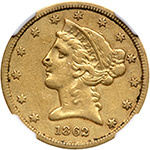 |
1862-S. NGC graded XF Details, Improperly Cleaned. Very scarce date. In 1988, Walter Breen in his Encyclopedia stated, "Prohibitively rare above VF, unknown above EF" in regard to the 1862-S Half Eagle. David Akers called this date: "One of the really great rarities of the half eagle series," remarking that he had never seen an example of the date that was "full EF." Of course, the comments by Akers were made three decades ago and new discoveries are sometimes made, but surprisingly little has actually changed since then regarding this date. It is still an elusive coin in all grades. Small pit at Liberty�s nose and some dark verdigris on the reverse near the rim. Only 9,500 struck (PCGS # 8293) .
Estimated Value $1,800 - 1,900.
View details and enlarged photos
Check results on similar lots
| Unsold |
|
|